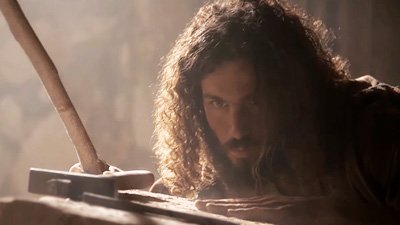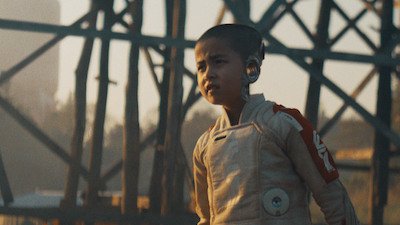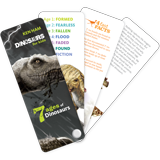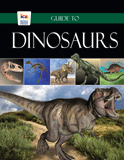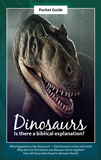65 Review
When Star Trek meets Jurassic Park!
Dinosaur movies are popular, and so are space movies. Throw both together in a movie with a huge (if somewhat predictable) twist, and it is easy to see why people would be interested in the movie 65. We often point out the need to be aware of evolutionary propaganda hidden in media. While the presence of evolutionary ideas does not necessarily mean one needs to boycott the film, we need to be prepared to discuss these ideas, especially with youth who may watch the movie.
Spoiler Alert: This review reveals certain elements of the movie’s plot, but only to the extent necessary to convey the negative and positive aspects of the film.
Loving Dad Makes Drastic Decision to Get Medicine for His Daughter
We often point out the need to be aware of evolutionary propaganda hidden in media.
The story opens on a beach on the planet Somaris, which is quite technologically advanced. Mills, played by Adam Driver, is there with his (unnamed) wife and daughter, Nevine (played by Chloe Coleman). Nevine is suffering from some serious illness which will require lots of money to cover. Some sweet family scenes include Mills telling Nevine that he is not going away “because of her” but “for her” and also him teaching her to fist whistle. Mills makes the decision to take a two-year interstellar mission where he will return some important people (possibly diplomats) to their home planets.
The plots move forward rapidly, and next we see military (or commercial) star pilot Mills (no first name is ever given) boarding the ship as the passengers are put into cryogenic containers to slow their aging for the long trip ahead. Mills then also goes into suspended animation shortly after the ship takes off. Mills takes some holographic videos of his daughter with him to remind him of his reason for taking such a long-term mission.
Smashes, Crashes, and Dashes
At some point in the flight, likely after a year (because one video of his daughter says that he’s halfway there), the spaceship begins to be pelted by asteroids. The ship’s computer voice repeats several times that this was an unexpected asteroid field. Mills, as the pilot, is awakened early in the bombardment but not early enough to do much good. He takes over manual control of the ship, but he is not experienced in dodging asteroids. Part of this may be why the computer also notes that they are in uncharted space. Mills mentions several times in the film that he has no idea where they are.
While it’s difficult to tell how long the bombardment lasts and how long it was going on before Mills is awakened, it becomes apparent that they are not on the outskirts of the asteroid belt, but right in the middle of it. It may be that the belt being depicted is the Kuiper Belt, but we never do find out. Smaller hits damage the ship, but a side strike from a huge asteroid critically damages it and rips a hole in the side. As the ship is going down, Mills tries to make the best of the inevitable crash landing, but some of the cryogenic tubes are sucked out just as the ship breaks in half upon colliding with a mountain. Mills is safely able to land his half of the craft but is injured in the process, and everyone in the cryogenic tubes near him are dead.
After surveying the scene around him and discovering all the dead passengers, Mills is racked with grief. Knowing that he might not be able to be rescued and that he only has a limited supply of resources, we see a brief scene showing Mills contemplating suicide, but looking at pictures or holographic stills of Nevine, or conversely, having vivid memories of his daughter flash through his mind, quickly firms his resolve to keep going and hoping to get back to her. One thing that is not adequately explained in the movie is whether those stills keep being downloaded to his holograph player. It seems like they must be (more on that later).
While out looking for survivors, he is unknowingly watched by some type of eellike creature that surfaces right behind him, though we never see this creature in full, nor do we ever see it again. A short time later (maybe the next day, maybe a week later) he gets a signal from one of his scanners that there is another survivor. After trekking a short distance and discovering some geysers (hinting that they may be on earth and in Yellowstone) he discovers a 9- or 10-year-old girl named Koa (as he finds out later from the ship’s manifest) and frees her from the cryogenic tube and brings her back to the (half-) ship. He also discovers that Koa (played by Ariana Greenblatt) doesn’t speak the same language, that she is wary of him, and that they must make hand gestures to communicate. She does start to pick up on Mills’ language (English, of course) by repeating what he says and listening to his tone. She quickly learns what “Run!” means.
Here There Be Dragons
Mills finds out that the other half of the ship also survived the crash, but that there are no other life forms. However, that part of the ship has a contingency escape ship attached to it that sensors show to still be operational. Koa wants to know about her family, and Mills deceptively tells her that her family is on the mountain where the other half of the ship crashed.
As they trek to the mountain, they are attacked by raptors and a possible type of rauisuchid (possibly Postosuchus) and menaced by pterosaurs and even giant insects, including vinegarroons. They inevitably suffer minor injuries along the way. Mills is able to fight them off with his laser gun and some type of spherical grenade that is also extremely powerful.
During the first night, they camp inside a cave with a waterfall at its entrance, and Mills sets up some proximity sensors to warn them of anything getting close. He also lets Koa play some of the holographic messages his daughter recorded for him. This scene quickly becomes eerily reminiscent of The Lost World: Jurassic Park, especially the huge dinosaur (that at a quick glance seems to be reminiscent of a Tyrannosaurus rex—though the arms are way too long for that to be the case) which appears in front of the waterfall and isn’t afraid to poke his nose through the waters (like the Tyrannosaur in JP2). The large dinosaur starts thrashing about after Mills shoots it, and this causes the entrance of the cave to collapse. Due to this, they must traverse through the dark cavern and eventually dig their way out (aided by a grenade).
They both get out but in separate locations, and Mills shortly finds himself sinking in quicksand (another possible Yellowstone clue, as there are vast wetlands there). Just as he gets completely sucked under, Koa arrives and bends a branch down into the water and helps him get free. Mills then has twinges of regret for lying to Koa about her family, and he tries to tell her the truth, but she doesn’t understand him.
Mountains, Melting Dinosaurs, and Meteors
They finally ascend the mountain and discover the other half of the ship and the escape ship. Mills then learns that his messages got through to his agency (or company) and that they are sending a rescue operation to meet him at some unspecified rendezvous. Koa learns that her parents and/or other family members are dead and begins to grieve. Mills (who earlier had played a hologram of his wife telling him that his daughter had died peacefully in her sleep) now tells Koa that the girl in the videos she has been watching was his dead daughter and this seems to form a “family” bond between them. As they get ready to take off, a meteor storm kicks off, and a small meteor hits the ship, causing the escape craft onboard to nosedive down the mountain. Because the orientation is wrong for takeoff, they must get it righted or they will never get off the planet. Mills also tells Koa that these are small meteors, but the big one that wrecked their ship is heading for a direct impact somewhere on this planet.
Of course, a loud crash only serves to bring more huge and hungry dinosaurs. This ends up being not one, but two (possibly a mated pair) of Tyrannosaurus rexes, though these individuals actually have the arms to match. Mills gets himself out of the seat belt he was strapped into and decides to see if he can draw the dinosaurs off, but he very quickly gets cornered by both theropods. Koa decides to play a hologram in the direction of the dinosaurs to distract them. This works, and Mills is able to kill one of the animals with a shot to the eye. After noticing where the hologram light is coming from, the remaining rex heads back toward the ship and conveniently flips it over so it is facing up.
Mills manages to kill this one as well with some kind of laser shotgun. However, before the duo has much of a chance to celebrate their survival, the mystery theropod from the cave scene arrives, likely drawn to their location by the loud commotion of roaring and gunfire. Mills realizes he needs to draw this one away before it destroys the ship. He takes off running and soon learns he’s near some geysers like (or probably) the ones he encountered earlier in the film, which he inexplicably seems to know the timing of (Old Faithful allusion?). He hops over the geyser and rolls out of the way just as the large dinosaur gets scalded by the eruption. But the dinosaur is now enraged and is about to chomp down on Mills when Koa arrives and stabs it in the eye with a thagomizer (stegosaur tail spike) she found the previous day. This causes it to thrash around and set off the geyser prematurely, which cooks the dinosaur for good.
They both get back to the ship as the computer voice warns them that impact is imminent. They manage to safely take off amidst the meteor swarm and make it outside the planet’s atmosphere just as a huge meteor slams into the planet some distance away from where they had been. Although the audience knew it all along, this confirms that they were on earth allegedly 65 million years ago, and it was the Chicxulub meteor depicted. Indeed, we see the devasting effect on the planet as the escape ship passengers look down.
The Good the Bad and the Unexplained
It was refreshing to see a mom and dad care for their daughter’s health problems and to see the love the entire family had for each other. Mills having regret over lying to Koa and then his being patient with and forming a stepfatherly bond with her, even when she was being difficult, was also good to see. Mills comes off as a loving, self-sacrificing father and surrogate father. Koa, after she learns to trust Mills, saves his life twice, and although sad at the death of her family, she seems glad that Mills was there with her and that they are going home.
While the movie obviously is taking as fact the evolutionary story of the demise of the dinosaurs resulting from the Chicxulub meteor, this is not even revealed until the last few minutes of the movie. The concept of an advanced alien race having developed interstellar travel over 65 million years ago is also a radical concept built on evolutionary assumptions, but this is never really focused on in the movie, just matter-of-factly portrayed.
Then there’s the unexplained. When Mills stops himself from committing suicide, it is almost certainly because he expects to see his daughter again. After all, she was sick but not deathly so when he left, and his trip was going to make the best medicine available to her. But he later views the message that she had died but keeps that to himself and doesn’t let Koa know until she finds out about her family. This begs the question of when he knew his daughter had died. Also left unsaid but perhaps hinted at: Did Mills’ ship happen to knock some of the asteroids in the asteroid belt out of their positions and send them hurtling to earth? Was he responsible (indirectly) for the extinction of the dinosaurs and many other life forms on earth (according to the evolutionary Chicxulub impact hypothesis).
Creature Compendium
As expected, there is a modest variety of extinct wildlife shown off in 65, from small beetles (if the size of your hand is considered small) to massive theropod dinosaurs.
Now let’s talk about the fauna presented in this film. The film doesn’t strictly follow the known localities of where some of these animals were found, so we will leave out discussion of whether certain animals should really have been featured or not. As expected, there is a modest variety of extinct wildlife shown off in 65, from small beetles (if the size of your hand is considered small) to massive theropod dinosaurs. We do get hints at the presence of many creatures such as the bellows of sauropods, the presence of a broken-off thagomizer from an unknown species of stegosaur, and even a “blink and you miss it” scene where Mills picks up a manus (hand) claw from the geyser field that appears to be from a yet-unnamed theropod known by paleontologists simply as a megaraptor.
First on our list of animals that we actually see are the arthropods. Several are encountered throughout the film, including a large and unidentified species of extinct beetle, a moderately sized centipede, and even vinegarroons—which interestingly enough, look identical to their “evolutionary descendants” found today. There’s some food for thought.
Next, we have the pterosaurs. From what we could tell, two distinct genera of flying reptile were seen in 65. The ones we mainly see throughout the film appear to be related to or representing Dsungaripterus. Why Dsungaripterus, a genera whose fossils are found in the Junggar Basin of China, is seen in what is clearly ancient North America is unknown. The other genera we see is unidentifiable because we only ever see its feet as it briefly snatches one of the Dsungaripteruses out of the air. However, based on its size and locality, we can assume that it is likely intended to be a Pteranodon or a young Quetzalcoatlus.
Lastly, we have the dinosaurs. Unfortunately, we realized early on from watching the trailers that this film was not striving for accuracy with its “terrible lizards.” And the variety of the dinosaurs represented is very scarce. From the quick glimpse we had of them, only two dinosaurs seen in the film truly reflect what we believe they were intended to be.
Early on in the film, we see a pack of raptors in the distance (possibly Deinonychus) being followed closely by a large, mostly unseen theropod. One of these young Deinonychus later attacks Koa, eventually cornering her in a log. Another small dromaeosaur ambushes Mills and is quickly killed, though it is clear that it has a “healthy” amount of quills, hinting at dinosaur-to-bird evolution, but not enough to be in your face.
Later, we briefly see a small herd of dinosaurs, one of which is stuck in some type of tar. However, once free and the full body exposed, it is clear this is no real dinosaur. It had the body plan of a large theropod, non-weightbearing front limbs, a tyrannosaur-like head, and then out of the blue, a clubbed tail like Ankylosaurus. Why? We have no clue, but at this point in the film our expectations were drastically reduced. You could easily name this creature “Mosaicosaurus.”
Surprisingly, there is a brief scene inside the cave where Mills is attacked by a type of dinosaur whose appearance in a likely North American environment might seem strange. However, we believe the dinosaur represented here is the recently named theropod dinosaur Anzu wyliei. This is a type of oviraptorid that has thus far been found in the Hell Creek Formation of Montana, as well as the Dakotas. The T. rexes mentioned above make an appearance, though artistic liberties were taken with their portrayal with the arms being extremely lanky compared to the bulky arms of the real animal and the animals’ bodies being excessively covered in spikes.
Then we have the mystery animals. The small-pack predators that travel on all fours and hunt our characters midway through the film don’t resemble any known dinosaur, though they do seem to resemble the hybrid Indoraptor from Jurassic World: Fallen Kingdom. The best we could liken them to would be a type of rauisuchid, which of course is not a dinosaur. The last creature is the large theropod dinosaur that we briefly see in the cave sequence and later as it chases Mills through the geyser field. This animal also does not truly resemble any known dinosaur but appears to have been heavily influenced by the fictional Vastatosaurus rex from 2005’s King Kong and even by the hybrid Indominus rex from 2015’s Jurassic World.
Back to the Bible
Regarding the film’s title, 65 is obviously referring to the evolutionary millions-of-years timeline, but again here, the film is a bit off-kilter since the current secular paradigm is that the end of the Cretaceous was 66 million years ago. (But perhaps a movie titled 66 would have brought to mind cheap souvenir stands on the scenic Route 66 in Arizona and New Mexico).
But from a biblical perspective, we know that dinosaurs and pterosaurs did not go extinct in some great catastrophe such as the Chicxulub asteroid, but rather they survived the greatest natural catastrophe the world has ever seen—the catastrophic worldwide flood of Noah’s day described in Genesis. Though most of their populations were wiped out because of the flood, two of each kind (for the dinosaurs) or seven pairs of each kind (for the pterosaurs, being that they were flying creatures) were saved on the ark built by Noah and lived beyond the events of Genesis 6–9. Sadly however, over time and as a result of sin, these amazing reptiles passed on to the pages of history with only some written records of people’s experiences with them and their fossils left behind.
And Scripture says that mankind is unique, created in the image of God (Genesis 1:26–28, 9:6), and the earth is unique, created to be inhabited (Isaiah 45:18). There are no other intelligent “alien” lifeforms out there, no “goldilocks planets,” and the earth and universe are not billions of years old. Scripture teaches divine creation of everything in the universe within the past 6,000+ years.
[Christ] is the image of the invisible God, the firstborn of all creation. For by him all things were created, in heaven and on earth, visible and invisible, whether thrones or dominions or rulers or authorities—all things were created through him and for him. And he is before all things, and in him all things hold together. (Colossians 1:15–17)
Recommended Resources

Answers in Genesis is an apologetics ministry, dedicated to helping Christians defend their faith and proclaim the good news of Jesus Christ.
- Customer Service 800.778.3390
- © 2024 Answers in Genesis


